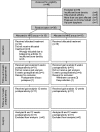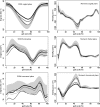Gait analysis after total hip replacement with hip resurfacing implant or Mallory-head Exeter prosthesis: a randomised controlled trial
- PMID: 20473670
- PMCID: PMC3080493
- DOI: 10.1007/s00264-010-1040-6
Gait analysis after total hip replacement with hip resurfacing implant or Mallory-head Exeter prosthesis: a randomised controlled trial
Abstract
A key to the analysis of function after total hip replacement (THR) is the ability to identify gait adaptations specific to design features and surgical procedures. In a randomised controlled design, we evaluated the mechanics of gait after THR with a hip resurfacing system or conventional prosthesis. We also investigated whether gait adaptations returned to normal postoperatively. Similar improvements in mechanics of gait were found, except for peak abductor moments, which improved more in the conventional group. Gait speed increased significantly, but with no differences between groups. The increase in walking speed was reflected as significant improvement within groups in most kinematic and kinetic variables. Significant differences between the operated and non-operated hip were seen in all patients, but with no difference between groups. Mean curves of joint angle profiles and moments in all anatomical planes during a gait cycle revealed that gait impairment persisted with no differences between the conventional prosthesis and the resurfacing system.
Figures


Similar articles
-
Resurfacing versus conventional total hip arthroplasty - review of comparative clinical and basic science studies.Bull NYU Hosp Jt Dis. 2009;67(2):120-7. Bull NYU Hosp Jt Dis. 2009. PMID: 19583538 Review.
-
Gait analysis of patients with resurfacing hip arthroplasty compared with hip osteoarthritis and standard total hip arthroplasty.J Arthroplasty. 2007 Jan;22(1):100-8. doi: 10.1016/j.arth.2006.03.010. J Arthroplasty. 2007. PMID: 17197316 Clinical Trial.
-
Gait analysis after total hip arthroplasty using direct anterior approach versus anterolateral approach: a systematic review and meta-analysis.BMC Musculoskelet Disord. 2019 Feb 8;20(1):63. doi: 10.1186/s12891-019-2450-2. BMC Musculoskelet Disord. 2019. PMID: 30736783 Free PMC article.
-
Hip resurfacing generates a more physiological gait than total hip replacement: A case-control study.Orthop Traumatol Surg Res. 2020 May;106(3):527-534. doi: 10.1016/j.otsr.2019.12.020. Epub 2020 Apr 4. Orthop Traumatol Surg Res. 2020. PMID: 32265178
-
No difference in gait recovery after THA with different head diameters: a prospective randomized study.Clin Orthop Relat Res. 2013 Dec;471(12):3830-7. doi: 10.1007/s11999-013-2926-6. Clin Orthop Relat Res. 2013. PMID: 23640204 Free PMC article. Clinical Trial.
Cited by
-
Sagittal plane gait characteristics in hip osteoarthritis patients with mild to moderate symptoms compared to healthy controls: a cross-sectional study.BMC Musculoskelet Disord. 2012 Dec 20;13:258. doi: 10.1186/1471-2474-13-258. BMC Musculoskelet Disord. 2012. PMID: 23256709 Free PMC article. Clinical Trial.
-
Improving Planning and Post-Operative Assessment for Total Hip Arthroplasty.Eur J Transl Myol. 2015 Mar 11;25(2):4913. doi: 10.4081/ejtm.2015.4913. eCollection 2015 Mar 11. Eur J Transl Myol. 2015. PMID: 26913152 Free PMC article.
-
Variability of gait in the early postoperative period of total knee arthroplasty with different surgical technique.Int Orthop. 2014 Mar;38(3):517-23. doi: 10.1007/s00264-013-2115-y. Epub 2013 Oct 10. Int Orthop. 2014. PMID: 24114244 Free PMC article.
-
Resurfacing hip arthroplasty better preserves a normal gait pattern at increasing walking speeds compared to total hip arthroplasty.Acta Orthop. 2019 Jun;90(3):231-236. doi: 10.1080/17453674.2019.1594096. Epub 2019 Apr 1. Acta Orthop. 2019. PMID: 30931667 Free PMC article. Clinical Trial.
-
Does the Femoral Head Size in Hip Arthroplasty Influence Lower Body Movements during Squats, Gait and Stair Walking? A Clinical Pilot Study Based on Wearable Motion Sensors.Sensors (Basel). 2019 Jul 23;19(14):3240. doi: 10.3390/s19143240. Sensors (Basel). 2019. PMID: 31340548 Free PMC article.
References
-
- Davis R, Ounpuu S, Tyburski D, Gage J. A gait analysis data collection and reduction technique. Hum Mov Sci. 1991;10:575–587. doi: 10.1016/0167-9457(91)90046-Z. - DOI
Publication types
MeSH terms
LinkOut - more resources
Full Text Sources
Medical

